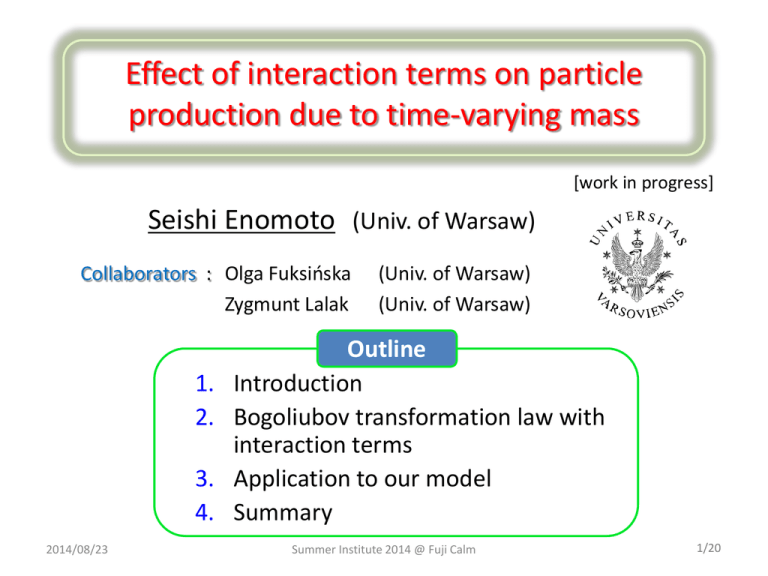pptx
advertisement

Effect of interaction terms on particle production due to time-varying mass [work in progress] Seishi Enomoto (Univ. of Warsaw) Collaborators : Olga Fuksińska Zygmunt Lalak 1. 2. 3. 4. 2014/08/23 (Univ. of Warsaw) (Univ. of Warsaw) Outline Introduction Bogoliubov transformation law with interaction terms Application to our model Summary Summer Institute 2014 @ Fuji Calm 1/20 1. Introduction x ■ Particle production from vacuum ■ It is known that a varying background causes production of particles ■ Oscillating Electric field pair production of electrons [E. Brezin and C. Itzykson, Phys. Rev. D 2,1191 (1970)] ■ Changing metric gravitational particle production [L. Parker, Phys. Rev. 183, 1057 (1969)] [L. H. Ford, Phys. Rev. D 35, 2955 (1987)] ■ Oscillating inflaton (p)reheating [L. Kofman, A. D. Linde, A. A. Starobinsky, Phys. Rev. Lett. 73, 3195 (1994)] [L. Kofman, A. D. Linde, A. A. Starobinsky, Phys. Rev. D 56, 3258 (1997)] ■ etc… 2014/08/23 Summer Institute 2014 @ Fuji Calm 2/20 ■ Example of scalar particle production 𝑔 : coupling 1 2 ■ Let us consider : ℒ𝑖𝑛𝑡 = − 𝑔2 𝜙 2 𝜒 2 𝜙 : complex scalar field (classical) 𝜒 : real scalar particle (quantum) ■ If 𝜙 goes near the origin… mass of 𝜒 (𝑚𝜒 = 𝑔𝜙) becomes small around 𝜙 = 0 kinetic energy of 𝜙 converts to 𝜒 𝜒 particles are produced !! 𝑚𝜒 ■ produced occupation number : 𝑛𝜒𝑘 ≡ 0in out† out 𝑎𝜒𝐤 𝑎𝜒𝐤 = 𝑉 ⋅ exp 0in 𝑘 2 +𝑔2 𝜇2 −𝜋 𝑔𝑣 [L. Kofman, A. D. Linde, X. Liu, A. Maloney, L. McAllister and E. Silverstein, JHEP 0405, 030 (2004)] 2014/08/23 Summer Institute 2014 @ Fuji Calm 𝝌 𝝌 𝝌 𝝌 𝑡 𝑣 Im 𝜙 𝜇 𝜙 Re 𝜙 3/20 ■ Our interests 1. How about supersymmetric model? 2. How do (quantum) interaction terms affect particle production? ■ Usually production rates are calculated in the purely classical background We would like to estimate the contribution of the quantum interaction term 𝜙 𝜒 quantum 𝜓𝜒 classical quantum classical 𝜓𝜙 2014/08/23 Summer Institute 2014 @ Fuji Calm 4/20 ■ Model in this talk Φ = 𝜙 + 2𝜃𝜓𝜙 + 𝜃 2 𝐹𝜙 ■ Super potential : 1 Χ = 𝜒 + 2𝜃𝜓𝜒 + 𝜃 2 𝐹𝜒 𝑊 = 𝑔Φ𝑋 2 2 𝑔 : coupling Interaction terms in components : 1 2 4 1 2 2 2 ℒ𝑖𝑛𝑡 = −𝑔 𝜙 𝜒 − 𝑔 𝜒 − 𝑔𝜙𝜓𝜒 𝜓𝜒 + 𝑔𝜓𝜙 𝜓𝜒 𝜒 + (ℎ. 𝑐. ) 4 2 ■ Stationary point : ■ 𝜒 = 𝜓𝜙 = 𝜓𝜒 = 0 , but 𝜙 can have any value Im 𝜙 ■ Masses ■ 𝜙 ≠ 0 𝜒, 𝜓𝜒 : mass = 𝑔𝜙 , 𝜓𝜙 : massless Production may be possible 2014/08/23 Impossible…? Summer Institute 2014 @ Fuji Calm 𝜙 Re 𝜙 Our main study! 5/20 ■ Towards the calculation of produced numbers 1. Solving Equations of Motion for field operators : 1 2 𝜙 : 0 = 𝜕 2 + 𝑔2 𝜒 2 𝜙 + 𝑔𝜓𝜒† 𝜓𝜒† 𝜒 : 0 = 𝜕 2 + 𝑔2 𝜙 2 + 𝑔2 𝜒 𝜓𝜙 : 0 = 𝜎𝜇 𝜕𝜇 𝜓𝜙 + 𝑖𝑔𝜒 ∗ 𝜓𝜒† 1 2 2 † † 𝜒 + 𝑔𝜓𝜙 𝜓𝜒 ∗ † ∗ † 𝜓𝜒 :Our 0 =approach 𝜎𝜇 𝜕𝜇 𝜓𝜒 + 𝑖𝑔𝜙 𝜓 + 𝑖𝑔𝜒 𝜓𝜙 : 𝜒 Using Yang-Feldman equation 2. Bringing out creation/annihilation operators from field operators in in in 𝜙 𝑎in 𝜒 𝜓𝜙 𝑎𝜓 𝜓𝜒 𝑎𝜓 𝑎𝜒𝐤 𝐤 𝐤 𝜙𝐤 out 𝑎𝜙𝐤 𝜙 out 𝑎𝜒𝐤 out 𝑎𝜓 𝜙𝐤 𝜒 out 𝑎𝜓 𝜒𝐤 3. Estimation of produced numbers 𝑛𝑘 = 0in 𝑎𝐤out† 𝑎𝐤out 0in 2014/08/23 Summer Institute 2014 @ Fuji Calm 6/20 2. Bogoliubov transformation law with interaction terms ■ An example with a real scalar field Ψ ■ Operator field equation : 0 = 𝜕 2 + 𝑀2 Ψ + 𝐽 ■ Commutation relation : Ψ 𝐱 , Ψ(𝐲) = 𝑖𝛿 3 𝐱 − 𝐲 Formal solution (Yang-Feldman equation) 𝑥0 Ψ 𝑥 = 𝑍Ψas 𝑥 − 𝑖𝑍 𝑑𝑦 0 𝑑 3 𝑦 Ψ as 𝑥 , Ψ as 𝑦 𝐽(𝑦) 𝑡 as 𝑍 : some const. Ψ as : asymptotic field 0 = 𝜕 2 + 𝑀2 Ψ as 𝐽(𝑦) Ψ as (𝑥) 𝐽(𝑦) 𝑥 + 𝐽(𝑦) 2014/08/23 Summer Institute 2014 @ Fuji Calm 7/20 ■ Relation between in- & out-field operator ■ Set 𝑥 0 = 𝑡 out ≡ +∞ +∞ Ψ 𝑡 out = 𝑍Ψ as 𝑡 out − 𝑖𝑍 𝑑 4 𝑦 Ψ as 𝑡 out , Ψ as 𝑦 𝐽 𝑦 𝑡 as +∞ = 𝑍Ψin 𝑡 out − 𝑖𝑍 𝑑 4 𝑦 Ψ in 𝑡 out , Ψ in 𝑦 “as” = “in” 𝐽 𝑦 −∞ “as” = “out” = 𝑍Ψ out 𝑡 out 1 Ψ out 𝑥 out = Ψ in 𝑥 out − 𝑖 𝑍 𝑑 4 𝑦 Ψ in 𝑥 out , Ψ in 𝑦 out 𝑎𝐤 2014/08/23 𝐽 𝑦 in 𝑎𝐤 Summer Institute 2014 @ Fuji Calm 8/20 ■ Representation of 𝑎𝐤as with field operator ■ Ψ as is free particle, so we can expand with plane waves as Ψ as 𝑥 = 𝑑 3 𝑘 𝑖𝐤⋅𝐱 as 0 as as∗ 0 as† 𝑒 Ψ (𝑥 )𝑎 + Ψ 𝑥 𝑏−𝐤 𝑘 𝑘 𝐤 3 2𝜋 plane wave (time dependent) wave func. creation/annihilation op. 0 = Ψ𝑘as + 𝐤 2 + 𝑀2 Ψ𝑘as ■ inner product relation : Ψ𝑘as∗ Ψ𝑘as − Ψ𝑘as∗ Ψ𝑘as = 𝑖/𝑍 which comes from conditions 𝑎𝐤as , 𝑎𝐤as† = 2𝜋 3 𝛿 3 𝐤 − 𝐤 ′ , 𝑍 Ψ as 𝐱 , Ψ as 𝐲 ′ 2 2014/08/23 𝑎𝐤as = −𝑖𝑍 𝑡→𝑡 as = 𝑖ℏ𝛿 3 𝐱 − 𝐲 𝑑 3 𝑥 𝑒 −𝑖𝐤⋅𝐱 Ψ𝑘as∗ Ψas − Ψ𝑘as∗ Ψas Summer Institute 2014 @ Fuji Calm 9/20 ■ Bogoliubov transformation law ■ Relation between 𝑎𝐤in and 𝑎𝐤out out 2 𝑎𝐤 = −𝑖𝑍 1 𝑑 3 𝑥 𝑒 −𝑖𝐤⋅𝐱 Ψ𝑘out∗ Ψout − Ψ𝑘out∗ Ψout Ψ out 𝑥 out = Ψ in 𝑥 out − 𝑖 𝑍 𝑑 4 𝑦 Ψ in 𝑥 out , Ψ in,∗ 𝑦 𝐽 𝑦 in† 𝑎𝐤out = 𝛼𝑘 𝑎𝐤in + 𝛽𝑘 𝑎−𝐤 − 𝑖 𝑍 𝑑 4 𝑥 𝑒 −𝑖𝐤⋅𝐱 𝛼𝑘 Ψ𝑘in∗ − 𝛽𝑘 Ψ𝑘in 𝐽(𝑦) (ordinary) Bogoliubov tf law 𝛼𝑘 ≡ −𝑖𝑍 Ψ𝑘out∗ Ψ𝑘in − Interaction effects Ψ𝑘out∗ Ψ𝑘in 𝛽𝑘 ≡ −𝑖𝑍 Ψ𝑘out∗ Ψ𝑘in∗ − Ψ𝑘out∗ Ψ𝑘in∗ 2014/08/23 Summer Institute 2014 @ Fuji Calm Ψ𝑘in = 𝛼𝑘 Ψ𝑘out + 𝛽𝑘 Ψ𝑘out∗ Ψ𝑘out = 𝛼𝑘∗ Ψ𝑘in − 𝛽𝑘∗ Ψ𝑘in∗ 𝛼𝑘 2 − 𝛽𝑘 2 =1 10/20 ■ Produced (occupation) number : 𝑛𝑘 = 0in 𝑎𝐤out† 𝑎𝐤out 0in = = in† 𝛽𝑘 𝑎−𝐤 −𝑖 𝑍 𝑉 ⋅ 𝛽𝑘 0 2 𝑑4 𝑥 𝑒 −𝑖𝐤⋅𝐱 𝛼𝑘 Ψ𝑘in∗ − 𝛽𝑘 Ψ𝑘in 𝐽 2 𝛽𝑘 ≠ 0 +⋯ +𝑍 |0in 𝑑 4 𝑥 𝑒 −𝑖𝐤⋅𝐱 Ψ𝑘in∗ 𝐽 |0in 2 +⋯ 𝛽𝑘 = 0 Particles can be produced even if 𝛽𝑘 = 0 ! 2014/08/23 Summer Institute 2014 @ Fuji Calm 11/20 3. Application to our model ■ Equation of Motion (again) : 1 𝜙 : 0 = 𝜕 2 + 𝑔2 𝜒 2 𝜙 + 2 𝑔𝜓𝜒† 𝜓𝜒† 𝜒 : 0 = 𝜕 2 + 𝑔2 𝜙 2 + 2 𝑔2 𝜒 𝜓𝜙 : 0 = 𝜎𝜇 𝜕𝜇 𝜓𝜙 + 𝑖𝑔𝜒 ∗ 𝜓𝜒† 𝜓𝜒 : † 0 = 𝜎𝜇 𝜕𝜇 𝜓𝜒 + 𝑖𝑔𝜙 ∗ 𝜓𝜒† + 𝑖𝑔𝜒 ∗ 𝜓𝜙 1 2 † † 𝜒 + 𝑔𝜓𝜙 𝜓𝜒 ■ EOM for asymptotic fields (as = in, out): 𝜙 as : 0 = 𝜕 2 𝜙 as 𝜒 as : 0 = 𝜕 2 + 𝑔2 𝜙 2 𝜒 as as as 𝜓𝜙 : 0 = 𝜎𝜇 𝜕𝜇 𝜓𝜙 𝜓𝜒as : 2014/08/23 𝜙 : macroscopic 𝜒 , 𝜓𝜙 , 𝜓𝜒 : microscopic 0 = 𝜎𝜇 𝜕𝜇 𝜓𝜒as + 𝑖𝑔 𝜙 ∗ 𝜓𝜒as† Summer Institute 2014 @ Fuji Calm 12/20 ■ Solutions for Asymptotic fields Im 𝜙 ■ Assuming 𝜙 = 𝜙 (𝑡) for simplicity, then ■ 𝜙 as = 𝜙 as + 𝑑 3 𝑘 𝑖𝐤⋅𝐱 𝑒 2𝜋 3 as 𝜙𝑘as 𝑎𝜙𝐤 ■ 𝜒 as 𝑍𝜒 𝜒𝑘in ∼ = 𝜕 2 + 𝑔2 𝜙 2 𝜒 as 1 2𝐤 𝑒 −𝑖 𝐤 𝑡 as† as 𝜒𝑘as 𝑎𝜒𝐤 + 𝜒𝑘as∗ 𝑏𝜒−𝐤 1 2𝜔𝑘 exp −𝑖 𝜔𝑘 ≡ 𝑡 𝑑𝑡 ′ 𝜔𝑘 (𝑡 ′ ) 𝐤 2 + 𝑍𝜙 𝑔2 𝜙 (analytic continuation) 𝛽𝜒𝑘 ∼ −𝑖 exp 2014/08/23 𝑍𝜙 𝜙𝑘out = 𝜙𝑘out = 𝛼𝑘∗ 𝜙𝑘in − 𝛽𝑘∗ 𝜙𝑘in∗ 𝑑 3 𝑘 𝑖𝐤⋅𝐱 𝑒 2𝜋 3 = Re 𝜙 as† 𝜙𝑘as∗ 𝑏𝜙−𝐤 𝛽𝜙𝑘 = 0 𝜙 𝜇 𝑍𝜙 𝜙𝑘in = 𝑍𝜙 𝜙 in = 𝑣𝑡 + 𝑖𝜇 , 0 = 𝜕 2 𝜙 as + 𝑣 ( valid for 𝑡 ≳ 1/ 𝑔𝑣 ) 2 𝑘 2 +𝑔2 𝜇2 −𝜋 2𝑔𝑣 Summer Institute 2014 @ Fuji Calm Im 𝑡 Re 𝑡 𝜒 out 𝜒 in 13/20 ■ Solutions for Asymptotic fields ■ as 𝜓𝜙 = 𝑑 3 𝑘 𝑖𝐤⋅𝐱 𝑒 2𝜋 3 ±,in 𝑍𝜙 𝜓𝜙𝑘 = eigen spinor for helicity op. : 𝑘 𝑖 𝜎 𝑖 𝑒𝐤± = ± 𝐤 𝜎 0 𝑒𝐤± +,as +as −,as∗ −as† 𝑒𝐤+ 𝜓𝜙𝑘 𝑎𝜓𝜙𝐤 + 𝑒𝐤− 𝜓𝜙𝑘 𝑎𝜓𝜙 −𝐤 ±,out 𝑍𝜙 𝜓𝜙𝑘 = 𝑒 −𝑖 𝐤 𝑡 as 0 = 𝜎𝜇 𝜕𝜇 𝜓𝜙 𝛽𝜓±𝜙 𝑘 = 0 ■ 𝜓𝜒as = 𝑑 3 𝑘 𝑖𝐤⋅𝐱 𝑒 2𝜋 3 ± 𝑠,in 𝑍𝜒 𝜓𝜒𝑘 ∼ 1 2 + 𝑠,as 𝑠 𝑎𝜓𝜒𝐤 𝑠=± 𝑒𝐤𝑠 𝜓𝜒𝑘 1− 𝑔𝑣𝑡 𝜔𝑘 ± 1+ 𝑔𝑣𝑡 𝑖𝜃 𝑠 𝑒 𝑘 𝜔𝑘 0 = 𝜎𝜇 𝜕𝜇 𝜓𝜒as + 𝑖𝑔 𝜙 ∗ 𝜓𝜒as† 𝜔𝑘 ≡ exp −𝑖 𝑡 𝑑𝑡 ′ 𝜔𝑘 𝑡 ′ ( valid for 𝑡 ≳ 1/ 𝑔𝑣 ) 𝐤2 + 𝑍𝜙 (analytic continuation) 2014/08/23 − 𝑠,as∗ 𝑠† 𝑎𝜓𝜒−𝐤 𝑠† − 𝜎 0 𝑒−𝐤 𝜓𝜒𝑘 𝑔2 𝜙 𝛽𝜓𝑠 𝜒𝑘 2 , 𝑠 𝑖𝜃 𝑘 𝑒 ≡ ∼ −𝑠 ⋅ exp Summer Institute 2014 @ Fuji Calm 𝑠 𝐤 −𝑖𝑔𝜇 𝐤 2 +𝑔2 𝜇2 𝑘 2 +𝑔2 𝜇2 −𝜋 2𝑔𝑣 14/20 ■ Produced Particle number ■ 𝑛𝜒𝑘 = 2 × 𝛽𝜒𝑘 ■ 𝑛𝜓𝜒 𝑘 = 2 + ⋯ = 2 × exp 𝑠 𝛽 𝑠=± 𝜓𝜒 𝑘 2 𝑘 2 +𝑔2 𝜇 2 −𝜋 𝑔𝑣 + ⋯ = 2 × exp +⋯ 𝑘 2 +𝑔2 𝜇 2 −𝜋 𝑔𝑣 +⋯ leading term is obtained ■ 𝑛𝜙𝑘 = 2 × 𝛽𝜙𝑘 ■ 𝑛𝜓𝜙 𝑘 = 2 +⋯=0+⋯ 𝑠 𝑠=± 𝛽𝜓𝜙 𝑘 2 +⋯=0+⋯ Focus on! need to calculate next to leading order 2014/08/23 Summer Institute 2014 @ Fuji Calm 15/20 ■ Leading term of 𝑛𝜓𝜙𝑘 𝑛𝜓𝜙 𝑘 = = in 𝑍𝜙 𝜓𝜙𝑘 𝑍𝜒 𝜒𝑘in s,out† s,out in 0in 𝑎𝜓 𝑎𝜓𝜙 𝐤 0 𝜙𝐤 𝑠 𝑔2 𝑍𝜙 𝑍𝜒2 ∼𝑉⋅𝑔 = ∼ 𝑠 𝑟,in 𝑍𝜒 𝜓𝜒𝑘 𝐤+𝐩 2 𝑠 𝑍𝜙 𝑍𝜒2 𝑑4 𝑥 in∗ 𝑒 −𝑖𝐤⋅𝐱 𝜓𝜙𝑘 𝑑3𝑝 2𝜋 3 1 𝑠,𝑟 2 ⋅ 1− 𝜒 in∗ ⋅ 𝑠† in† in 2 𝑒𝐤 𝜓𝜒 |0 𝐩⋅𝐤 𝑠𝑟 𝑝𝑘 𝑑𝑡 𝑡 1 −𝑖 𝑑𝑡 ′ 𝜔𝑘 𝑡 ′ 𝑒 2𝜔𝑘 ∼ 𝜒 𝜓𝜙 𝐩 X 𝜓𝜒 +⋯ 𝜒 in 𝐤+𝐩 𝑠 𝑟,in 𝜓𝜒𝑝 2 Im 𝑡 𝑒 −𝑖 𝐤 𝑡 1 2 in∗ 𝜓𝜙𝑘 𝐤 1 𝑔𝑣𝑡 −𝜔 𝑘 Re 𝑡 +𝑠 1+ 𝑔𝑣𝑡 𝑖𝜃 𝑟 𝑒 𝑘 𝜔𝑘 𝑒 −𝑖 𝑡 𝑑𝑡 ′ 𝜔𝑘 𝑡 ′ steepest decent method We estimated in special case 𝐤 = 0 with steepest decent method 2014/08/23 Summer Institute 2014 @ Fuji Calm 16/20 ■ Analytical Result @ 𝑘 = 0 𝑔2 𝑔2 𝜇 2 𝑛𝜓𝜙 𝑘=0 /𝑉 = 𝐶 ⋅ ⋅ exp −𝜋 4𝜋 𝑔𝑣 Γ 4/3 2 6 𝐶= 𝜋𝑒 1/3 𝜋 5/6 (c.f.) 𝑛𝜒𝑘=0 /𝑉 ∼ 𝑛𝜓𝜒 𝑘=0 /𝑉 ∼ 2 × exp ∼ 0.32 𝑔2 𝜇 2 −𝜋 𝑔𝑣 ■ Produced number of 𝜓𝜙 is suppressed by factor 𝑔2 comparing with 𝜒 or 𝜓𝜒 ■ This results is consistent with perturbativity 2014/08/23 Summer Institute 2014 @ Fuji Calm 17/20 ■ Leading term of 𝑛𝜙𝑘 (only final formula) out† out in out† out in ■ 𝑛𝜙𝑘 ≡ 0in 𝑎𝜙𝐤 𝑎𝜙𝐤 0 + 0in 𝑏𝜙𝐤 𝑏𝜙𝐤 0 𝑎 ≡ 𝑎 − 𝑎 ,𝑏 ≡ 𝑏 − 𝑏 ⋮ =𝑉⋅𝑔 𝐤+𝐩 𝜙 + X 𝑑𝑡 1 4 2 + 𝑍𝜙2 𝑍𝜓 𝜒 𝜒 𝜙 × 𝐤+𝐩 𝐤 𝜙 in in 𝑑𝑡 𝜙𝑘out 𝜒 in 𝜒 ⋅ 𝑔 𝜙 𝐤+𝐩 𝑝 𝑍𝜙2 𝑍𝜒2 𝜒 𝐤 𝐩 𝑑3 𝑝 2𝜋 3 2 𝐩 𝑑𝑡 𝜙𝑘out 𝑠,𝑟 X + 1 + 𝑠𝑟 𝜙𝑘out 𝜓𝜒 𝑑𝑡 𝜒 in 𝐤+𝐩 ⋅𝑔 2 in∗ 𝜙 𝐩⋅ 𝐤+𝐩 𝑝 𝐤+𝐩 + 𝑠,in 𝜓𝜒 𝐤+𝐩 𝜙𝑘out 𝜒𝑝in 2 + 𝑟,in 𝜓𝜒𝑝 − 𝑠,in 𝜓𝜒 𝐤+𝐩 2 − 𝑟,in 𝜓𝜒𝑝 2 +⋯ 𝜓𝜒 2014/08/23 Summer Institute 2014 @ Fuji Calm 18/20 ■ Numerical Results ( 𝑔 = 1, 𝑣 = 0.5, 𝜇 = 0.05 ) 2.7 × 10−3 0.15 × 10−3 0.32 × 𝑔2 × 4𝜋 2014/08/23 consistent with analytical expected value 𝑘 2 + 𝑔2 𝜇2 ∼ 2 × exp −𝜋 𝑔𝑣 Summer Institute 2014 @ Fuji Calm 19/20 4. Summary 1. We constructed the Bogoliubov transformation taking into account interaction effects 2. We calculated produced particle’s (occupation) number ■ 𝑛𝜒𝑘 = 𝑛𝜓𝜒 𝑘 ∼ 𝑉 ⋅ 2 exp 𝑘 2 +𝑔2 𝜇 2 −𝜋 𝑔𝑣 𝑠 ■ 𝑛𝜓 , 𝑛𝜙𝑘 ≠ 0 𝜙𝑘 ■ Massless particle can be produced, however the production is suppressed by the coupling ( ∼ 𝑔2 /4𝜋 ) ■ However, the produced number in case of strong couplings may be comparable to massive particles 2014/08/23 Summer Institute 2014 @ Fuji Calm 20/20 2014/08/23 Summer Institute 2014 @ Fuji Calm 21/20 ■ Numerical Results 2 ( 𝑔 = 4, 𝑣 = 0.5, 𝜇 = 0.05 ) 2014/08/23 Summer Institute 2014 @ Fuji Calm 22/20






